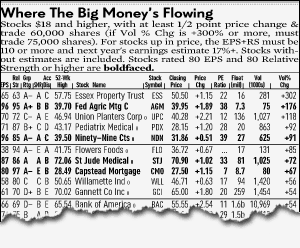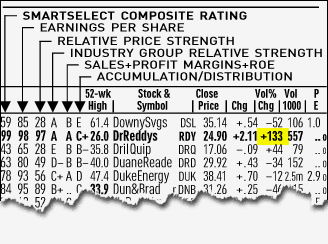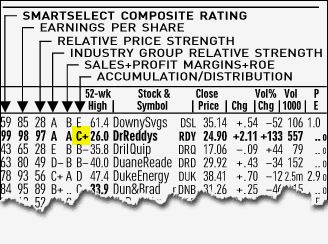Your Stock Buying Checklist � A Review
step-by-step guide to finding stocks with the characteristics
that make them market winners. This lesson reviews stock
buying concepts presented in this course.
Investor's Business Daily's Key Buy Rules
#4. Are Professional Investors Buying The Stock?
Mutual funds and other professional investors represent
a large percentage of the market's trading activity.
Their buying and selling power can dramatically influence
a stock's price.
Buy a stock the funds are buying and you should be
in good company. But if you get into a stock the funds
are selling, watch out. Funds have experienced teams
of analysts that identify the better companies. But
be sure you're following the smart money -- funds that
have top performance records.

(For Sample Purposes Only)
The most unusual trading activity is found in Stocks
On The Move, in both the New York Stock Exchange and
Nasdaq stock tables.
In the middle of the example above, St. Jude Medical
shows a price jump of $1.02 on a volume increase of
72%. The stock is boldfaced, underscoring its 87 EPS
Rating and 86 Relative Price Strength Rating. Its Industry
Group Relative Strength, SMR and Accumulation/Distribution
Ratings are all A or B.
You can spot the earliest indication of unusual trading
activity in the Volume Percent Change (Vol % Chg) column
of IBD's stock tables, which shows how much trading
volume changed yesterday vs. the stock's average over
the past 50 trading days.

(For Sample Purposes Only)
In our Dr. Reddy's example, volume was up 133% over
average trading volume and the price was up $2.11, suggesting
heightened activity by major investors.
The home page of investors.com features "Where
The Big Money's Flowing Now" and tracks big-volume
changes throughout the day by noting the 14 NYSE or
Nasdaq stocks with the largest increases in trading
volume.
You can measure professional buying with IBD's proprietary
Accumulation/Distribution Rating. Based on an A to E
scale, "A" represents heavy buying and, at
the opposite end, "E" represents heavy selling.
This rating is enhanced by "+" and "-"
symbols.
- Look for stocks rated "A." Stocks rated
"B," experiencing moderate buying, are also
worth considering. "C"-rated stocks are
neutral and may be O.K.

(For Sample Purposes Only)
Dr. Reddy's Accumulation/Distribution Rating is "C+",
meaning buying and selling trends in this stock have
been basically neutral.
The lesson titled "Sponsorship: Catching The Stocks
The Pros Are Buying," explains the influence of
professional investors on individual stocks.
#5. Market Direction
It is imperative to know the general market's direction
and to follow its trend. When the market turns down,
three out of four stocks will also fall -- even quality
stocks.
- Watch the daily price and volume movements of the
major market averages (Dow, Nasdaq and S&P 500),
looking for "distribution" that may herald
a downtrend and - on the flip side - "follow-throughs"
that may indicate a new uptrend.
- Read IBD's "The Big Picture" column to
understand the market's health.
- Find out if the market is favoring big-capitalization
or small-capitalization stocks. Check IBD's charts
on "Big-cap Growth Funds Vs. Small-Cap Growth
Funds" and "Value Funds Vs. Growth Funds."
Focus your research on whichever is moving higher.
- Also check the S&P 500 and Dow indexes (which
represent big-caps) and the S&P 600 (which represents
small-caps).
investors.com
|